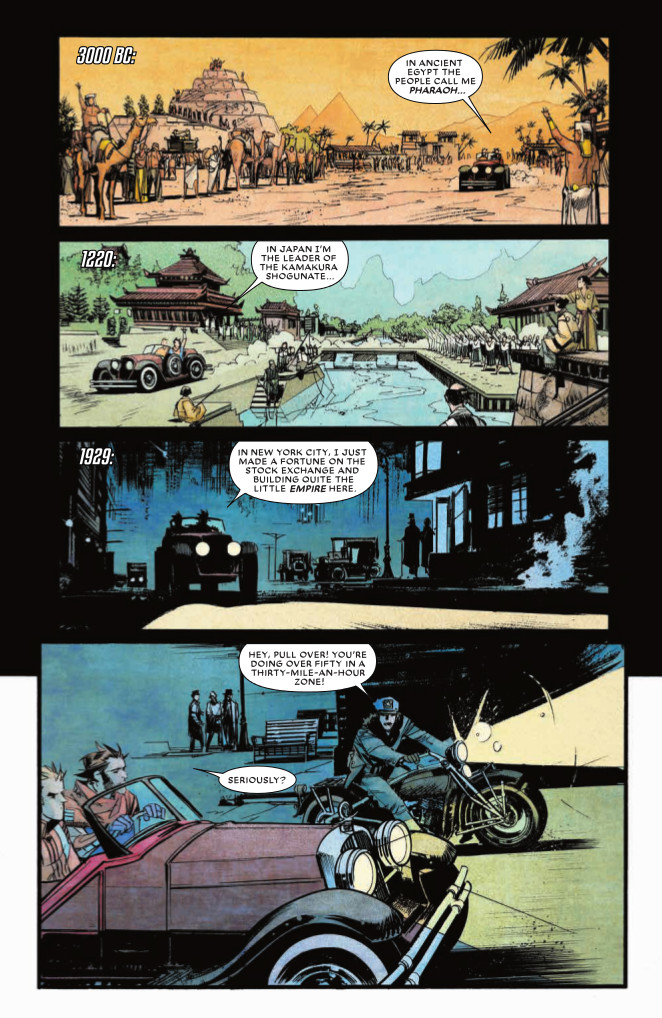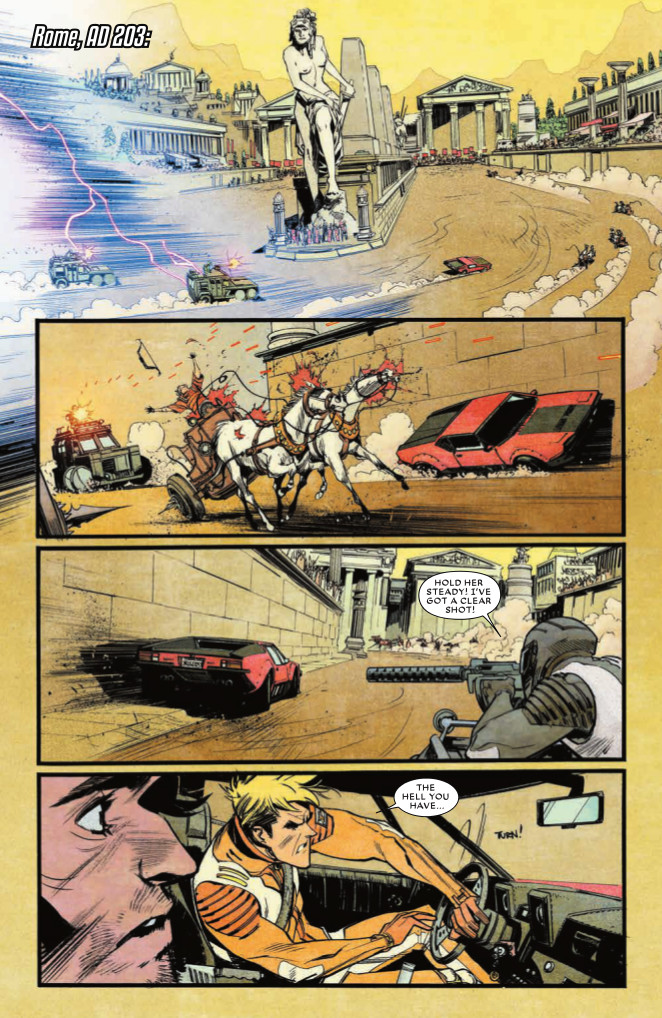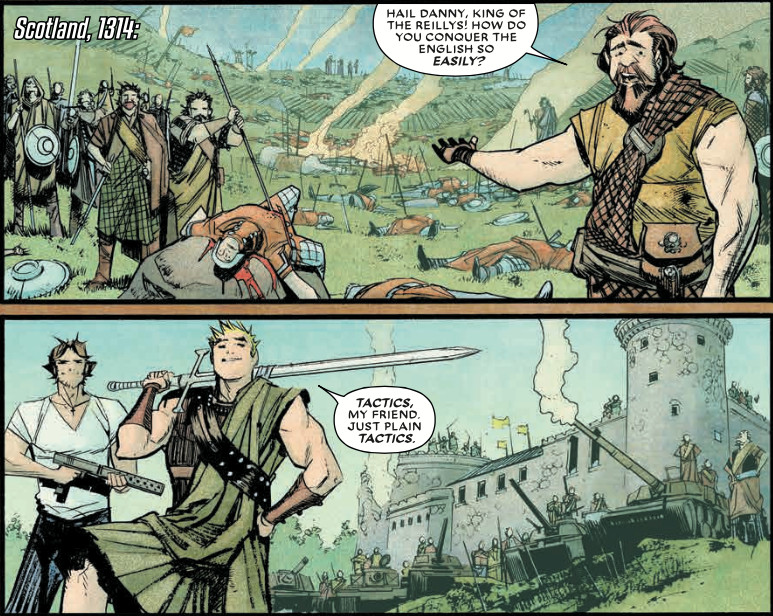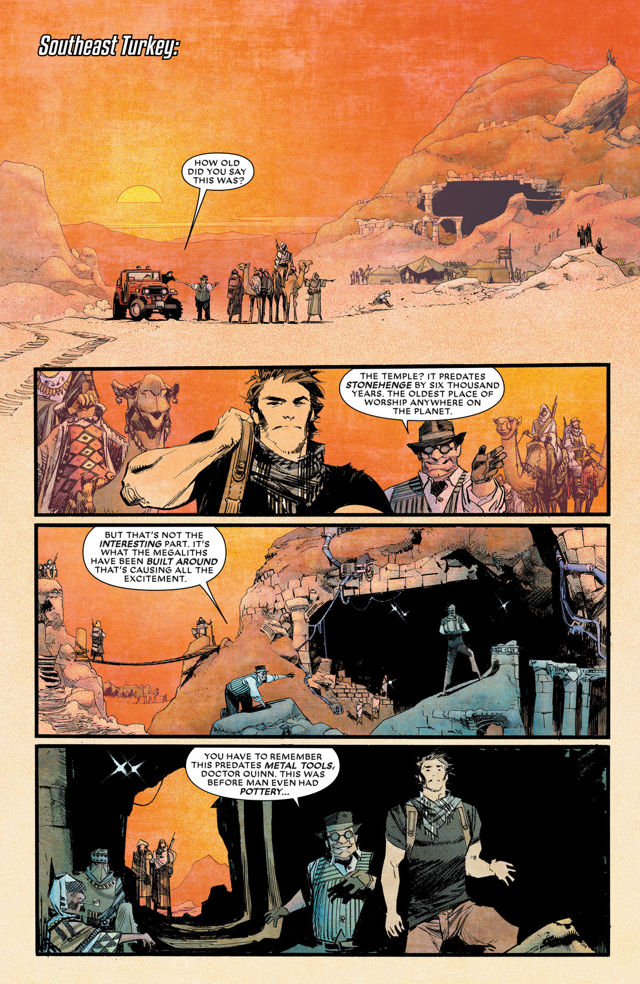Millar and Murphy Make the Most Commercial Comic Ever in Chrononauts
And that's not a bad thing
There’s something about the word “commercial” that really annoys people.
When a piece of art is perceived as “commercial” in nature, a lot of people get in a tizzy and start decrying it from the very get go. If it’s a movie made for the explicit purpose of putting butts in the seats rather than for the craft, it’s a bad thing. If it’s a TV show meant to entertain rather than provoke thought, it can mean people downplay it. With comics? Some people would rather tout a bad creator-owned comic than one that is made by a big publisher and designed simply to be a fun read.
 It’s an interesting phenomenon, and one that is really put to the test by Mark Millar and Sean Murphy’s Chrononauts. This recent Image Comics release is a compelling example because it’s both a creator-owned comic and one that is supposed to be light fun. As with many Millar books, it reads like something designed to get movie studios interested in adapting it—which makes sense given that a day after its debut issue’s release they announced a movie deal—and it’s one of the main few reasons pundits have issues with Millar as a creator. He doesn’t really do anything that challenges readers overtly with his work, instead playing to the masses, and his comics tend to be accused of being storyboards for his movies.
It’s an interesting phenomenon, and one that is really put to the test by Mark Millar and Sean Murphy’s Chrononauts. This recent Image Comics release is a compelling example because it’s both a creator-owned comic and one that is supposed to be light fun. As with many Millar books, it reads like something designed to get movie studios interested in adapting it—which makes sense given that a day after its debut issue’s release they announced a movie deal—and it’s one of the main few reasons pundits have issues with Millar as a creator. He doesn’t really do anything that challenges readers overtly with his work, instead playing to the masses, and his comics tend to be accused of being storyboards for his movies.
But is that such a bad thing? Is approaching a comic from an extremely populist point of view wrong?
Not in my opinion.
You see, I’m one of the people who calls himself a fan of Millar’s work. Are his books ever going to make lists citing the best comics ever made? Probably not. But comics like Starlight, Old Man Logan, his run on The Authority, and The Ultimates are some of the most enjoyable reads in comics you can find, and he always seems to pair up with incredible artists on his projects. Chrononauts was no different, as he was pairing with Murphy, an artist who makes the most out of every story. He has a special ability to take any moment and make it feel all the bigger. In books like The Wake and Joe the Barbarian, it’s hard not to see his work and think there’s something just bigger and more momentous going on within it. The way he visualizes stories and pages feels different—in a good way—than almost all of his peers. He can give a story immense scale and scope without sacrificing the story in the process.
In short, he’s a perfect collaborator for Millar. They’re both creators who can make commercial comics about as well as anyone, and with Chrononauts, they built an engine of pure commercialism, blending Top Gun, Back to the Future, Buckaroo Banzai, bromances and all kinds of other elements into a blockbuster smoothie. While what comes out isn’t a great comic, it is a good and, more importantly, fun one. As I said, there’s something to be valued there.
Chrononauts is the story of Corbin Quinn, the scientist responsible for the creation of time travel, and Danny Reilly, his guy Friday and right hand man (he’s also good at making time travel suits sleek and sexy). Initially, the idea is to send cameras back in time and observe, not interfere. As with the basis of any story, that’s not exactly what transpires. Quinn goes back in time, goes rogue, and decides to turn time into his personal play thing. When Reilly goes back in time to see if he’s okay, the duo teams up and lives a multi-era life where they date famous women, run armies, get filthy rich and live the life of time traveling kings. Does this sound like wish fulfillment in story form? Definitely. Does it work? Absolutely, and mostly because of its more fantasy world like elements.
 There’s something primal about this book that gives it a driving feel throughout. Murphy’s art is a big part of that, as Millar seemingly tailors his script to fit his artistic collaborator’s skill set and interests. There weren’t cars in ancient times? That’s okay. There are now, along with fighter jets and advanced weaponry, all operated by roving samurai. By themselves, Millar’s ideas may not work because of their lithe nature, but Murphy grounds everything in a jubilant realism that makes everything feel natural and much more impactful than it may have otherwise. When the titular duo are off gallivanting through time or solving the issue of someone gaining an advantage over them, this book thrives, and it’s clear in the high points of this book—fully realized in a montage across time in issue #3—that both creators are having a blast. Just like their creations.
There’s something primal about this book that gives it a driving feel throughout. Murphy’s art is a big part of that, as Millar seemingly tailors his script to fit his artistic collaborator’s skill set and interests. There weren’t cars in ancient times? That’s okay. There are now, along with fighter jets and advanced weaponry, all operated by roving samurai. By themselves, Millar’s ideas may not work because of their lithe nature, but Murphy grounds everything in a jubilant realism that makes everything feel natural and much more impactful than it may have otherwise. When the titular duo are off gallivanting through time or solving the issue of someone gaining an advantage over them, this book thrives, and it’s clear in the high points of this book—fully realized in a montage across time in issue #3—that both creators are having a blast. Just like their creations.
That’s where my issue with the negative connotations to the word “commercial” lies. Just because something is commercial, doesn’t mean it isn’t worthwhile. Stories like this one can be valuable if crafted well, and Chrononauts is a book that features an artist at the peak of his powers and one of the great idea men in comics doing their thing. When this book is on, it’s on in a way not dissimilar to some of the more entertaining blockbuster films of our times. Its energy might have more in common with the Indiana Jones trilogy or the aforementioned Top Gun than any comic that preceded it, but that’s not altogether a bad thing. There’s room in comics for bombastic stories that have more in common with movies than its own medium.

Where this book ultimately struggles is a third act face turn where we go from a fun romp to one built on sentiment. While Millar and Murphy bake that element into the story throughout, establishing why this type of thing might happen in the story, by the point it does it feels almost disingenuous for it to happen and for the characters to care enough to do so. Murphy makes the most of it, as the emotional points still hit, but the hollowness of these story beats resides in the plot mechanics. The very same thing that makes us enjoy this story from the get go exists in opposition to the final direction of the story. That element is why the final chapter of the story is the least enjoyable.
Some will also complain about the science of the time travel in the story, but I will not be one of them. If you’re reading a comic book and your takeaway from a story is something about it strikes you as unrealistic, I just have to ask you this: what part of Wolverine or Superman is realistic? This isn’t a story that’s worried about Quantum Mechanics, and really, why should it be? It’s a comic book, and one that is built for pleasure and not your comfort in their hard science.
 Beyond those two potential pitfalls, there are still more high points. Murphy’s art is brilliantly paired with the incomparable Matt Hollingsworth, a previous collaborator with Murphy and one who clearly gets how to best bring a story to life. His colors are rich and he gives each era its own weight, helping ground this fantastical story in the necessary realism we need to stay engaged. There’s one thing Hollingsworth always seems to do with his colors that I don’t see from other colorists that is hard to explain, but he does it very well here. You can see it to the right in the top panel. In shots like that sunrise, you can see a faint, white haze over the coming bursts of orange. It’s a subtle note, but there’s something about elements like those that make a story feel all the more real to me, and it’s a great example as to why Hollingsworth is amongst the very best colorists in the game.
Beyond those two potential pitfalls, there are still more high points. Murphy’s art is brilliantly paired with the incomparable Matt Hollingsworth, a previous collaborator with Murphy and one who clearly gets how to best bring a story to life. His colors are rich and he gives each era its own weight, helping ground this fantastical story in the necessary realism we need to stay engaged. There’s one thing Hollingsworth always seems to do with his colors that I don’t see from other colorists that is hard to explain, but he does it very well here. You can see it to the right in the top panel. In shots like that sunrise, you can see a faint, white haze over the coming bursts of orange. It’s a subtle note, but there’s something about elements like those that make a story feel all the more real to me, and it’s a great example as to why Hollingsworth is amongst the very best colorists in the game.
Does this book complete its landing unscathed? No. That’s okay. Chrononauts is an imperfect book, but one that you can pick up and read and be entertained and amused while still getting phenomenal art from two of the best visual creators in comics. It’s a romp in the best ways, and while the final turn of the book is unsatisfying at least to this reader, I can say this: I bet audiences in the theater are going to love it. Maybe that’s why some dislike the work of Millar, but with every comic, you have to take the sour with the sweet. And this one is a lot more sweet than sour. While it doesn’t do anything to deconstruct comics or reinvent the art form, Chrononauts is an enjoyable, breezy read with a unique idea and an almost palpable confidence to the storytelling. Comics aren’t always meant to be one thing, and thankfully, that’s not an idea this creative team subscribes to. They’re all about the good times.
Let the good times roll, I say.
